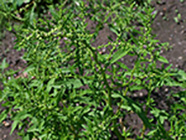
Other articles you might enjoy:
Make the most of culinary herbs and spices.

All About Epazote
by Sandra Bowens
photo courtesy of T. Voekler and Wikimedia Commons
As you learn about epazote the age-old question, "What's in a name?" may occur to you. While epazote sounds somewhat exotic, the other names for this Mexican herb are less appealing. Consider skunkweed, pig weed, wormseed or goosefoot. And then there is the fact that the word epazote comes from the Aztec words 'epatl' and 'tzotl' meaning smelly animal. Mexican tea is a nicer name as is the botanical Chenopodium ambrosioides. Let's just stick with epazote (say eh-pa-zo-tay) for this discussion.
Native to Central America, especially Mexico and Guatemala, epazote is common to those cuisines. It is most often used fresh in these regions to flavor beans, corn and fish. The strongly scented herb is said to help avoid the gastric discomfort that sometimes occurs after eating beans. Ancient Aztecs used epazote both medicinally and as a culinary herb.
The taste is strong as well, slightly bitter with hints of lemon. It is often compared to cilantro as both are acquired tastes. Epazote has no comparable substitute but we have found using Mexican oregano in its place provides pleasing results. Simply omitting it from a recipe is another option.
You might find fresh epazote for sale at Mexican grocery stores. Mexican food guru Rick Bayless notes in his book Mexico: One Plate at a Time that although the fresh herb may appear wilted, it is still okay for cooking. He also recommends storing the fresh stems in a glass of water, like a bouquet of flowers, or refrigerated wrapped in damp paper towels.
Dried epazote is available chopped or as whole stems. Recipes will occasionally call for a stem of epazote--roughly equal to a teaspoon of the dried chopped product.
It is easy to grow your own epazote if you like it enough to want a steady supply. The shrubby plant is an annual that grows about three or four feet high. Leaves are large and pointed with serrated edges while the flowers are tiny clusters of green balls. The crushed leaves are said to send ants scattering if placed in their path.
If you buy dried epazote for your own kitchen you may notice that some pieces seem rather woody. You can pick these tough stems out or try pulverizing it further with a mortar and pestle. The dried herb does soften plenty with extended cooking.
Try epazote in soups, with shellfish and eggs or as an ingredient in quesadillas. It is especially popular for flavoring beans of any kind. Epazote combines well with other Mexican seasonings like oregano, cumin and chiles.
You should be aware that this pungent herb is poisonous in large quantities but don't let that stop you from experimenting with a pinch or two.
Corn and Black Bean Salad with Tortilla Strip Croutons
For maximum flavor, make this salad the day before. Store in the refrigerator and bring to room temperature before serving. This salad also works as a salsa.
2 cups frozen corn kernels, cooked according to package directions and drained
1 can (15 ounces) black beans, rinsed and drained
1 can (4.5 ounces) diced green chiles
1 large clove garlic, minced
1 medium tomato, cored and diced
1 teaspoon ground coriander
3 Tablespoons olive oil
1 Tablespoon plus 2 teaspoons red wine vinegar
1 1/2 teaspoons finely chopped dried epazote
1/2 teaspoon Kosher salt
1/8 teaspoon ground black pepper
Tortilla strip croutons, recipe follows
Place the corn, black beans, green chiles, garlic and tomato into a large salad bowl. Sprinkle with the coriander and toss well.
Whisk together the oil, vinegar, epazote, salt and pepper; pour over the corn and bean mixture. Toss well. If time allows, cover and place in refrigerator overnight. Bring to room temperature before serving.
To serve, mound on a salad plate and scatter the tortilla croutons over the top.
Makes six 1/2 cup servings
Tortilla Strip Croutons
6 six-inch corn tortillas
Vegetable oil for frying
1 teaspoon salt
1 teaspoon ground cumin
Cut the tortillas in half, stack and slice into half-inch strips. Heat 1/2 inch of the oil in a deep, heavy saucepan over medium-high heat. Oil is ready when a test tortilla strip dipped into it sizzles heartily. Carefully drop about one-third of the strips into the hot oil; keep them moving with a slotted spoon and fry until crisp, about 4 minutes. Using the slotted spoon, carefully transfer to drain on layers of paper towels. Repeat two more times with remaining tortilla strips.
Mix together the salt and ground cumin. Sprinkle this mixture over the warm tortilla strips and toss lightly to coat.
Here's one that's full of our favorite recipes because we wrote the book! It is also full of information, helpful hints and ideas for using herbs and spices in your kitchen.
South of the border classics in less than 30 minutes? We can count on Rick Bayless to give us a roadmap to good food, fast.
Rosalind Creasy knows all about using food plants to round out your yard. She pioneered the idea 25 years ago. This updated edition includes 300 inspiring photographs.
Behold the power of sausage in this wonderful book about the life of early American emigrants. One of our favorites of all time!
Does garlic really repel vampires and cure the hiccups? Find answers to these questions and way more than you ever thought possible about the stinking rose.
Cook up some sunshine anytime of the year with a book that's as fun to read as it is to eat from. Alligator anyone?







